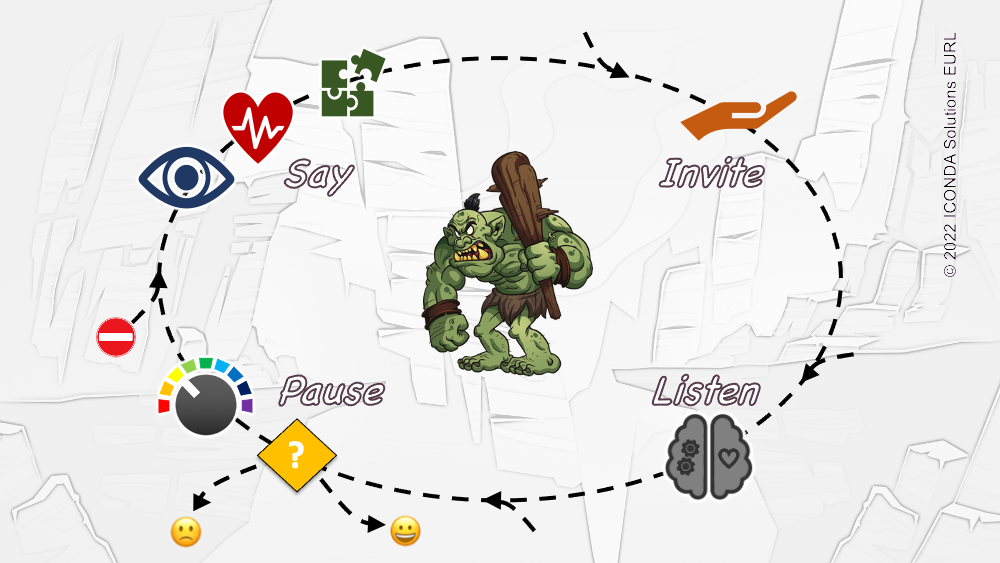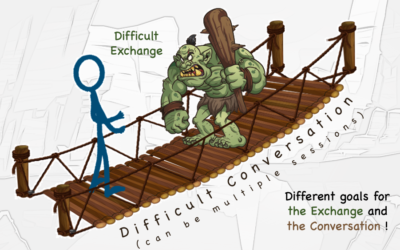“Happy families are all alike; every unhappy family is unhappy in its own way” (Leo Tolstoy, Anna Karenina, 1878).
We posit that a key attribute of happy families, and effective people in general, is that they can bring Difficult Conversations to a satisfactory conclusion. Such conversations are all alike – they finish with a calm discussion about what to do next.
If a Difficult Conversation cannot be resolved, however, the results are varied and often disastrous. For evidence, just look in the newspapers!
So how do happy families and effective people do it?
Here’s the scoop: they use a loop.
Rather than independently analysing a problem in order to find and then advocate solutions, protagonists repeatedly exchange viewpoints until there is sufficient mutual understanding for a calm discussion.
They have learnt how to find solutions together and are not afraid to try.
Difficult Conversations, Bridges and Trolls
In the preceding article, we likened a Difficult Conversation to a troll bridge where the troll represents the highly charged, emotional aspect of the conversation – the Difficult Exchange. Once this is reconciled and calm has been restored then the conversation may proceed in what we might call a normal way[1]. It may still be challenging and require good negotiation skills, for example, but it’s no longer difficult in the sense that emotions are dominant[2].
Our first suggestion with regards to Difficult Conversations is therefore to concentrate on the troll. To have confidence that, once the Difficult Exchange is reconciled and the troll is tamed, you and the other party will be able to find a solution together.
This raises the question, how can I reconcile a Difficult Exchange?
We hope that you find the Troll-Taming Loop described here to be so obvious that having read the article you will wonder why it was needed!
I can enter the loop at almost any point, go round multiple times and exit in one of two ways, as illustrated in the main diagram and described below.
Let’s look at the loop, bearing in mind that the key steps are expanded in later articles …
Pause
You might have thought that pausing would come naturally to anyone meeting a troll. However, most of us plough straight into Difficult Exchanges, relying on habit and instinct to get us through.
However, a lot of what has been learnt over the years about dealing with Difficult Exchanges is counterintuitive, and so habit and instinct cannot be relied upon. This is why the Pause step is so important. It is necessary to bring our feelings under control, gather our thoughts and then consciously decide what to do. In particular, we strongly recommend thinking about two things …
- What is the difficulty exactly?
- In addressing this difficulty, what is my fundamental intention?
The difficulty may seem obvious (based on instinct), but sometimes the obvious is misleading.
For example, instead of tackling a team member about their lateness for a meeting (“Chris, this meeting started at 10am and it is now 10h15, …”) I might realise that the real problem is that they are invariably late and that I fear they have no respect for me and their colleagues. The latter is a tougher problem, and I might easily avoid it (probably sub-consciously) if I do not pause to think. Dealing promptly with such difficulties helps avoid a build-up of issues that pollute relationships, both at work and home.
Unfortunately, I often avoid the toughest problems, preferring to deal with slightly easier ones instead. This is understandable, especially if I don’t have the right techniques.

In this context, I must not confuse my intention with regards to the Difficult Exchange with any objectives I might have for the conversation as a whole. My intention should be something simple – after all, the Pause step is a matter of a few seconds. I don’t have time to think of anything complicated. Something like “reassure”, “understand” or “clarify” would be just fine, for example. In contrast, my objective for the conversation (should I ever get that far) could be something much more elaborate, such as, “agree on who is responsible for organising the Technical Review Meeting with Acme Ltd”.
Plenty of other silent actions can be imagined for the Pause step. Taking a few seconds to calm down or, at least, to prevent emotions from overcoming reason is clearly important. Much has been written about this subject. However, we put special emphasis on the issues of identifying the real difficulty and adjusting intentions because our work has shown that their neglect leads to very disappointing results. If we don’t know the port to which we are sailing, then no wind is favourable!
Say



The next step is to Say how we see the situation, how we feel and what we need.
Our guidance here is inspired by the Non-Violent Communication (NVC – Marshall Rosenberg) principles on Observations, Feelings and Needs. In a nutshell (to be cracked open in future articles), the key to effective expression of these three is accuracy: describing the precisesituation, my real feelings and my genuine needs.
At the same time, brutal honesty can be dangerous, since the other party may have sensitivities of which we are not aware. I am trying to tame the troll, not beat it do death. The point is not to be right, but to find words that allow us to establish or restore a trusting relationship and hence to communicate effectively. I therefore strive to avoid triggering reactions such as defensiveness, resistance, argumentativeness or withdrawal. Therefore, while accuracy remains key, I have to both anticipate and monitor the effect that our words have on the other party, combining honesty with empathy and benevolence (see Levine, Roberts and Cohenb on Navigating the Tension between Honesty and Benevolence).
Invite and Listen
Having said what we see, feel and need, the next step is to simply Invite the other party to give their point of view. This can be done in a few words or just with a look. All that matters is that the other person understands our invitation.
Then I Listen attentively to how the other party sees things, trying to understand also how they feel about them and what they fundamentally need [3].
In certain cases, especially when the other person is angry or irritated, almost all my troll-taming efforts are concentrated in the Listen step, at the expense of Say! That is, when faced with someone in this state, attentive listening is just about the only thing I can do. Almost anything I say will make matters worse.
Loop again or exit

This last possibility is necessary since it’s not always possible to resolve a difficulty in one exchange, and sometimes I may conclude that I cannot succeed, at least not in the present circumstances or in the time available.
There are many reasons why this can happen. Perhaps time really is in short supply? Maybe safety is an issue and it’s better to take an executive decision rather than waiting to achieve consensus? Or perhaps, having endeavoured to use the Troll-Taming Loop (TTL) to get aligned with the other party, I decide that they do not wish to play win-win and that I should protect myself – fight or flee [4].
Acknowledging the possibility of failure has real value. For one thing, it reduces the stress inherent in tackling a Difficult Exchange, since I no longer feel obliged to ‘solve’ the difficulty (and certainly not with just one attempt).
It follows from this that taming the troll may require multiple attempts.
Suppose I’ve just supplied another group in my company with a software application and they send me an email full of complaints about it. I am furious. I find the comments in the email to be misguided and unfair. I reply as politely as I can, following the principles captured in the TTL, but the email exchange does not go well. Finally, we agree to a video call.
During this call, I follow the TTL once more, but both sides remain convinced that the other is being unreasonable. It’s an important subject for both of us – my pride is at stake, not to mention the result of my upcoming annual review, and the software is key to the other group’s productivity. The call ends in a stalemate with both parties deciding to go away and think about what can be done next.
Having worried all night, I arrange to visit the other group (who’s office is a couple of hours away). This gesture seems to be helpful in itself and this time each of us does a better job of expressing our points of view, our feelings about the situation and our needs/interests. The atmosphere relaxes and we are able to discuss alternative solutions without defensiveness or aggression. This exchange, which looked very difficult to start with, is reconciled and we are back to a normal, professional conversation.
This example illustrates that a Difficult Conversation may take a while to resolve, that it can contain several Difficult Exchanges and that not all of them will be reconciled.
Deliberate practice makes perfect
Of course, I need to practice in order to improve my skill in handling Difficult Exchanges, and I need to practice deliberately. I won’t become a great orator just by talking a lot nor will I become a great human being by simply breathing in and out! The key is deliberate practice – consciously repeating simple steps, building them into a sophisticated repertoire.
That’s how Usain Bolt became a great track athlete and Mark Knopfler a brilliant guitarist.
Ideas to help you with your deliberate practise for Difficult Conversations are described in further articles from this series, to answer questions such as:
- How should I adjust my intentions when approaching a Difficult Exchange?
- How can I use factual observations to get a Difficult Exchange on track?
- Is it a good idea to express my feelings and, if I do, how best to do it?
- How can I accurately convey what I fundamentally need?
- How do I close the loop, inviting and listening?
This series itself came out of work to create short, remote training courses. The need for brevity drove a number of innovations of which, we believe, the most important are:
- A focus on the Difficult Exchange part of the conversation
- Key things to do while pausing to take stock
- A particularly simple way to use Non-Violent Communication in this context.
The Troll-Training Loop pulls all of the above together, and we hope that you enjoy trying it out!
Andrew Betts and colleagues
Last modified: 30 July 2022
[1] In this context, a conversation may span multiple sessions and these could use a mix of styles – face-to-face, video conferencing and email, for example. The resolution of a difficult conversation may be achieved in a few minutes or it could take hours, days or months.
[2] This article is not only about how to deal with trolls, it is also about how to teach troll taming skills quickly and remotely. The flow that we will describe came out of an experimental training program on Leading Difficult Conversations in a high-tech multinational. To accommodate participants’ demanding schedules, the course had to teach people a new process remotely, in record time. These constraints led us to considerably simplify accepted theory and the methods used to teach it.
[3] Our guidance for the inviting and listening steps is primarily drawn from NVC. However, those familiar with NVC may have noticed that I have only referred to the Observations, Feelings and Needs aspects of the discipline, but not “Requests”. This is because our focus on the Difficult Exchange part of the conversation allows us to considerably simplify this aspect of NVC which, in our flow, has become the “Invite” step, encouraging the other party to express their point of view.
[4] In a professional setting, “fight” might mean escalating an issue to a higher authority, for example, and “flight” might mean avoiding the other party from now on, or even resigning from a position.
---
Other articles in this series
English articles : 1, 2, 3, 4, 5, 6, 7 , summary and notebook
Traductions en français : 1, 2, 3, 4, 5, 6, 7 , sommaire et cahier
Your feedback and suggestions
The Difficult Conversations eBook and articles are the result of many hours of collaborative work and they build upon a huge base of established wisdom.
I am grateful to everyone involved so far – trainees, fellow trainers and coaches, other authors … and I would also appreciate your comments and suggestions!
There is an online form or, if you prefer, an email to contact@icondasolutions.com would be fine.
As you may have noticed, ...
... the topics in this series on Difficult Conversations are organised hierarchically:
- Article 1: At the top level, a Difficult Conversation can be imagined as a bridge with a troll blocking the way, where the troll represents the Difficult Exchange which has to be sorted out before a normal conversation can resume. Our challenge is to tame the troll.
- Article 2: At the next level, we break our troll-taming method down into a four step loop: pause, say, invite and listen/decide. We go around this loop until we've Reconciled the Difficult Exchange and have returned to a normal conversation (dialog).
- Articles 3-7: Finally, each of the four steps has its own internal details and the refinement of these details takes us deeper still, as with any substantial subject.
We invite you to use the tools and models described in these articles to guide your practice and we hope that you find this hierarchical description helpful.
Comments, suggestions and enquires: contact@icondasolutions.com







